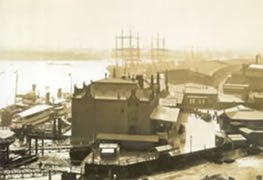Getting ready to travel
Emigration with or without passport
"......By chance I′ ve got the letter from America in a hand. It was from Michigan. It has discomfited me immediately and I′ ve made a firm resolution to move there too. The year 1866 came and through the homeland resounded turmoil of war, so there was no time to consider moving. But in one year I sold all my properties for 500 goldens, I paid my debt 100 goldens and 400 goldens have left for the road...".
Quotion from a letter of Jan Holecek, published in 1887 in the Czechoamerican calendar „Amerikan“
Once the decision had been taken, the next question was how to go about it. The full official way was a long and complicated one.
In the 1850s, newly created "District Offices" had taken over several of the administrative tasks that were until then maintained by individual parishes and manors. People who wanted to emigrate had to ask for passports in the new District Offices. When requesting a passport, people had to submit several documents including a copy of the birth record (krestni list), marriage (oddaci list), evidence of residence and occupation (domovsky list), supporting documents, and references. Applicants had to sign that they would waive their residence right to live in the village. If not, the village could be held liable for paying for return costs if emigration was refused or the people came back for other reasons.
The age and status of the man was one reason why emigration could be refused. One application record actually mentions that the request of a father for emigration by his six-year old son was refused "because the son had not yet fulfilled his duty as soldier in the Imperial Army"!


Remains of an uncollected passport and train station (© 2)
For that reason, many people emigrated illegal. Others just did not know or understand that an official permit was needed. They only asked for a copy of their birth record (still registered in the parish records) as proof of their identity. Until the end of the 19th century, illegal emigration was easy: the German and North-American authorities were not concerned with emigration permits or passports, any proof of identity was enough. If somebody went out illegally, that was not their concern.
Money was another problem. Those who had a farm sold it to raise the funds, others just had to save and sell their meager belongings or try different ways to raise the money needed to emigrate. In those years, around 150 gold pieces was considered enough for a family to travel to the USA.
Sometimes the whole family went together. In other cases, part of the family went earlier. For example, a man or some of the elder sons could go earlier to try find work to pay for the others to come as well, or to avoid the looming draft.
The first leg in the journey was getting to the ships. Most emigrants from the Czech lands went through Bremen (and its harbor site Bremerhaven) and Hamburg. They started out by walking or going by horse wagon to the nearest bigger town, in South Bohemia often Ceske Budejovice. From there, one could take a river barge on the Vltava (Moldau) or the train to Prague and farther to Germany, again either by train or by boat on the Elbe.


Ticket sales in Bremen, left (© 1) and sleeping room in Hamburg (© 2)
Arriving in the harbor, one often had to stay a few days in one of the many emigrant lodging houses, waiting for the day of departure. At the end of the 1800s, Hamburg created a large emigrant area were over 5000 people could sleep, eat, and wait for their departure. From there, sometimes they could embark directly onto the ships, other times they were brought out in smaller harbor barges to get to the large ships.


View of Hamburg harbor (© 2) and boarding (© 3).
Imagine that, with the exception of those drafted and involved in wars, most rural people never had been farther away from their homes than a few miles. Now they had arrived in an unimaginably large city herded together with thousands of other emigrants, many speaking a different language, waiting for an almost endless journey over a never-before seen ocean. Indeed a frightening experience.
Unless mentioned differently, all pictures are © collection Rozmberk Society, Friends of the Rozmberk Society, or provided under © by individual partners. In some instances, copyright is public domain or could not be established or obtained within reasonable effort.
1) Courtesy SOA Trebon
2) Courtesy Staatsarchiv Hamburg
3) Courtesy Denkmalschutzamt Hamburg
Design by the Bear (Robert Dulfer 2006-2016)


